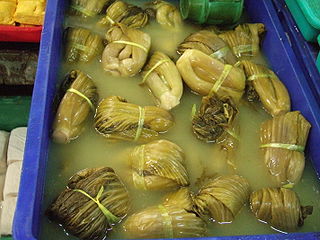
Sauerkraut is finely cut raw cabbage that has been fermented by various lactic acid bacteria. It has a long shelf life and a distinctive sour flavor, both of which result from the lactic acid formed when the bacteria ferment the sugars in the cabbage leaves. It is one of the best-known national dishes in Germany.

A blood sausage is a sausage filled with blood that is cooked or dried and mixed with a filler until it is thick enough to solidify when cooled. Most commonly, the blood of pigs, sheep, lamb, cow, chicken, or goose is used.

Kale, or leaf cabbage, belongs to a group of cabbage cultivars grown for their edible leaves, although some are used as ornamentals. Kale plants have green or purple leaves, and the central leaves do not form a head. Kales are considered to be closer to wild cabbage than most of the many domesticated forms of Brassica oleracea.

A cabbage roll is a dish consisting of cooked cabbage leaves wrapped around a variety of fillings. It is common to the cuisines of Central, Northern, Eastern and Southeastern Europe and much of Western Asia, Northern China, as well as parts of North Africa. Meat fillings are traditional in Europe, and include beef, lamb, or pork seasoned with garlic, onion, and spices. Grains such as rice and barley, mushrooms, and vegetables are often included as well. Fermented cabbage leaves are used for wrapping, particularly in southeastern Europe. In Asia, seafoods, tofu, and shiitake mushrooms may also be used. Chinese cabbage is often used as a wrapping.

Solyanka is a thick and sour soup of Russian origin that is common in Russia, Ukraine, and other states of the former Soviet Union and certain parts of the former Eastern Bloc. It was one of the most popular dishes of the former East Germany.
Norwegian cuisine in its traditional form is based largely on the raw materials readily available in Norway and its mountains, wilderness, and coast. It differs in many respects from continental cuisine through the stronger focus on game and fish. Many of the traditional dishes are the result of using conserved materials, necessary because of the long winters.

Pickling is the process of preserving or extending the shelf life of food by either anaerobic fermentation in brine or immersion in vinegar. The pickling procedure typically affects the food's texture and flavor. The resulting food is called a pickle, or, to prevent ambiguity, prefaced with pickled. Foods that are pickled include vegetables, fruits, meats, fish, dairy and eggs.

Czech cuisine has both influenced and been influenced by the cuisines of surrounding countries and nations. Many of the cakes and pastries that are popular in Central Europe originated within the Czech lands. Contemporary Czech cuisine is more meat-based than in previous periods; the current abundance of farmable meat has enriched its presence in regional cuisine. Traditionally, meat has been reserved for once-weekly consumption, typically on weekends. The body of Czech meals typically consists of two or more courses; the first course is traditionally soup, the second course is the main dish, and the third course can include supplementary courses, such as dessert or compote. In the Czech cuisine, thick soups and many kinds of sauces, both based on stewed or cooked vegetables and meats, often with cream, as well as baked meats with natural sauces (gravies), are popular dishes usually accompanied with beer, especially Pilsner, that Czechs consume the most in the world. Czech cuisine is also very strong in sweet main courses and desserts, a unique feature in European cuisines.

Rinderrouladen are a German meat dish, usually consisting of bacon, onions, mustard and pickles wrapped in thinly sliced beef which is then cooked. The dish is considered traditional also in the Upper Silesia region of Poland where it is known as rolada śląska and in the Czech Republic where it is known as španělský ptáček.

Suancai is a traditional Chinese pickled Chinese cabbage or Chinese mustard, used for a variety of purposes. Suancai is a unique form of paocai, due to the ingredients used and the method of production.

Schweinshaxe, in German cuisine, is a roasted ham hock. The ham hock is the end of the pig's leg, just above the ankle and below the meaty ham portion. It is especially popular in Bavaria as Schweinshaxn [ˈʃvaɪns.haksn̩] or Sauhax(n) [ˈsaohaks(n̩)]. A variation of this dish is known in parts of Germany as Eisbein, in which the ham hock is pickled and usually slightly boiled.

Zasmażana kapusta, known to many Polish people simply as kapusta [kah-POOS-tah], is a Polish dish of braised or stewed sauerkraut or cabbage, with bacon, mushroom and onion or garlic. It is seasoned with salt, pepper and sometimes bay leaf, caraway seeds, sugar, paprika and apples. The traditional dish is usually served along with boiled potatoes as an accompaniment for pork chops, pork cutlets, other pork dishes, veal, or game meats. In some homes, kapusta is served very thin, almost like a soup. In others, its ingredients are thickened with flour or cooked until it becomes nearly as thick as mashed potatoes. It has been described as less sour in flavor compared to German sauerkraut.

Silesian cuisine belongs to the region of Silesia in Central Europe. It is a subtype of Polish and German cuisine with many similarities to and signs of the influence of neighbouring cuisines. The cuisine is particularly renowned for its poppy seed and knödel dishes.

Tsukemono are Japanese preserved vegetables. They are served with rice as an okazu, with drinks as an otsumami (snack), as an accompaniment to or garnish for meals, and as a course in the kaiseki portion of a Japanese tea ceremony.
Toroi is a traditional Māori dish, made from mussels and a leaf vegetable, usually pūha or watercress. The ingredients are cooked together in mussel broth and stored in jars, preserved by undergoing fermentation by bacteria. Toroi can also seasoned with ingredients such as chilli and garlic during the fermentation process.













